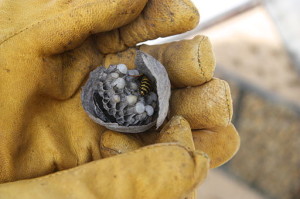How Do Yellowjackets Reproduce?
By Chris Williams on July 21, 2014.
 Yellowjacket wasps, like ants, are social insects, meaning that they all live together in a colony with a queen and with a division of labor. A single queen is “mom” to every wasp in the colony. All of the yellowjacket workers are basically sterile sisters who cooperate to raise and feed all of their younger siblings.
Yellowjacket wasps, like ants, are social insects, meaning that they all live together in a colony with a queen and with a division of labor. A single queen is “mom” to every wasp in the colony. All of the yellowjacket workers are basically sterile sisters who cooperate to raise and feed all of their younger siblings.
Yellowjacket Larvae are Helpless Grubs
Yellowjackets have what we entomologists call “complete metamorphosis” which means that they have a four-stage life cycle and that the immature stage looks and acts differently from the adult stage. A yellowjacket’s life stages are egg, larva, pupa, and adult. A larval yellowjacket is white, legless and grublike. Compare this to the incomplete metamorphosis of the cockroach. The immature cockroach is called a nymph and looks and acts like a miniature version of the adult cockroach. In incomplete metamorphosis there is no pupal stage between the immature and the adult insect.
Most of us (unless you’re a pest control technician) never see yellowjacket larvae. The reason is that they never leave the nest, and the nest is usually hidden in the ground, high in a tree, or in a wall void. Inside a wasp’s nest are layers of paper combs, each containing many honeycomb-like cells that, in turn, contain the developing yellowjackets.
A yellowjacket nest starts with a single, fertilized female queen who begins a paper nest and then lays eggs in the cells. The queen acts as nursemaid for her first batch of larvae, grooming and feeding them. When they are fully grown, the yellowjacket larvae pupate right in the cell where they grew up. After several days, a sterile, winged adult yellowjacket emerges from the cell.
The Number of Yellowjackets Increases Exponentially
This first group of yellowjacket workers then takes over the care and feeding of the growing colony. New cells are added to the nest as the number of larvae grows. Although it takes about 30 days for the first batch of workers to be produced, the colony then grows exponentially as the queen concentrates only on egg laying. In New Hampshire and Massachusetts, a yellowjacket colony is usually as big as it will get by late August. The size of a mature yellowjacket colony can vary from one hundred to several thousand wasps.
Late in the summer, the sterile workers start building larger nest cells which will house females and males, next year’s reproductives. The workers kill any other developing larvae and soon die themselves. When the reproductives turn into adult yellowjackets, they leave the nest and mate. In fall, these fertilized queens will find a protected place to spend the winter. In spring, each queen will start a new nest as the cycle continues.
By NABU-Oberberg (Own work) [CC-BY-SA-3.0], via Wikimedia Commons